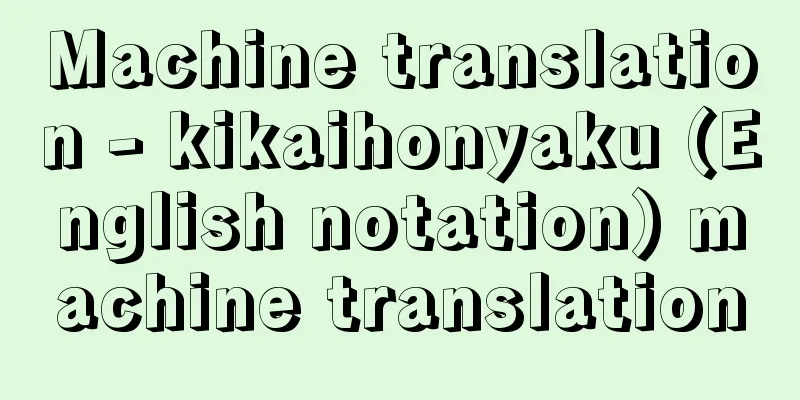Machine translation - kikaihonyaku (English notation) machine translation

|
The automatic translation of natural languages such as Japanese and English into other natural languages using a computer. It is also called automatic translation. The idea of using computers for translation is quite natural, and attempts to do so have been underway almost since the advent of computers. Natural language translation is not just about replacing words with foreign words; it is necessary to understand the meaning of the sentence from the context and convert it into a phrase unique to the native language in order to translate it into a meaningful sentence. For computers based on sequential processing, natural language translation has been considered one of the most difficult tasks, along with image and speech recognition. [Katsuaki Ono] Translation ProcedureMany people have tried various methods for machine translation, but here we will provide an overview of the mainstream methods. Here, we will call the text in the language to be translated the source language, and the text in the language to be translated the target language. The machine translation process can be divided into three stages: [1] Analysis: Analyze the structure of the input language and create an intermediate syntactic representation. [2] Conversion: Assigning a translation to an intermediate representation or replacing expressions extracted from the semantics with the corresponding phrases in the target language. [3] Synthesis: The converted intermediate representation is aligned in accordance with the syntax of the target language and any necessary inflections are made. Analysis is the part where the computer tries to understand the content of the sentence to be translated, and it plays a very important role in machine translation. It is roughly carried out in the following steps. (a) Morphological analysis: Breaking down a sentence into words. This is not a big challenge in Western languages that have spaces between words, but in agglutinative languages like Japanese, identifying words can be quite a difficult task. (b) Syntactic analysis: This involves determining the parts of speech of the words broken down in the previous step, determining the structure of verb phrases and noun phrases, and extracting subject-predicate relationships. This is the process of determining the structure of a given sentence in accordance with the rules of grammar. (c) Semantic analysis: How to express the meaning of a sentence using a computer is a future challenge. The structure of the sentence analyzed by syntactic analysis is checked to determine whether the meaning is valid or not. To achieve this, attempts are being made to assign "case" characteristics to dictionary entries and analyze the meaning in light of the syntax, as well as to apply logical algebra to replace the description of the sentence with a logical formula and analyze the meaning. (d) Context analysis (or pragmatic analysis): Given a sentence, the context is used to interpret sembles, supplement abbreviations, determine what pronouns refer to, and infer the subject and intent of the sentence. [Katsuaki Ono] IssuesThese analyses are not done mechanically in a sequential manner, but are interrelated, so that syntactic decisions must often be made in the light of semantic and contextual analysis. Furthermore, completing these steps mechanically would result in a translation that does not make sense. As an example of the difficulty of syntactic analysis, the English sentence "Time flies like an arrow" can be analyzed as either "Time flies like an arrow" or "The type of fly called time likes arrows." The task of automatically and perfectly translating natural language into another language is close to impossible as long as it is impossible to make a computer fully understand the meaning of a sentence. A recommendation document on machine translation research published in the United States in 1965 called the "ALPAC Report" pointed out this point. However, if the scope is limited, such as a specific field or specific application purpose, it is possible to produce translations of a fairly high quality, and by having a human do the final polishing, it can be useful for processing large volumes of translation on a regular basis. Also, various techniques that have been researched in relation to machine translation technology, especially semantic analysis techniques, have been of great use in research on artificial intelligence other than language translation. [Katsuaki Ono] [References] |Source: Shogakukan Encyclopedia Nipponica About Encyclopedia Nipponica Information | Legend |
|
コンピュータを用いて、日本語や英語などの自然言語を他の自然言語に自動的に翻訳すること。自動翻訳automatic translationともいう。コンピュータを翻訳に利用しようという発想はごく自然なものであり、その試みはコンピュータの出現とほぼ同じ時期に始められている。 自然言語の翻訳は、単に単語を外国語に置き換えるだけでは役にたたないため、文のもつ意味を文脈から理解し、その国語独特の言い回しに変換しなくては意味の通じる文章に翻訳することはできない。逐次的な処理に基づいたコンピュータにとって、自然言語の翻訳は、画像の認識や音声の認識と並んで、もっとも困難な仕事の一つとされてきた。 [小野勝章] 翻訳の手順機械翻訳の技法は、多くの人がいろいろな方法を試みているが、主流とされている手法について概要の説明を行う。ここで、翻訳される国語の文章を入力言語source languageとよび、翻訳すべき相手国語の文章を目標言語target languageとよぶことにする。 機械翻訳の手順は次の3段階に分けられる。 〔1〕アナリシス 入力言語の構造を分析して、中間的な構文表現をつくりだす。 〔2〕変換 中間表現に翻訳を割り当てたり、意味論から抽出された表現を目標言語の該当する言い回しに置き換えたりする。 〔3〕合成 変換された中間表現を目標言語の構文に即して整列させたり、必要な語尾変化を与えたりする。 アナリシスは、翻訳しようとする文の内容をコンピュータによって理解させようとする部分で、機械翻訳では非常に大きな役割をもつが、これは大略次の手順によって進められる。 (a)形態解析morpheme analysis 文章を単語に分解する。これは、欧米語のように単語の間を空白でくぎる言語では大きな困難はないが、日本語のような膠着(こうちゃく)語の場合は、単語の認定はかなり困難な問題を含んでいる。 (b)構文解析syntactic analysis 前段で分解された単語の品詞を決定し、動詞句、名詞句の構造を判定して主述関係を抽出する。与えられた文を、文法の規則に照らして構造を決める作業である。 (c)意味解析semantic analysis 文のもつ意味をコンピュータでいかに表現するかは、むしろこれからの課題であるといえる。構文解析で分析された文の構造をチェックして、意味が妥当であるか否かをここで判断する。このために「格」の特性を辞書項目に与え、これらを構文に照らして意味を分析する方法とか、論理代数を応用して文の記述を論理式に置き換え、意味の分析を行う方法などが試みられている。 (d)文脈解析context analysis(または語用論解析pragmatic analysis) 与えられた文の文脈から、文意に即した多義語の解釈、省略語の補足、代名詞が何をさすかということや、文の主題や意図の推定などが行われる。 [小野勝章] 問題点以上の分析は順を追って機械的に行われるものではなく、互いに関連しあっているので、構文の決定は意味論や文脈解析に照らして行わなくてはならない場面がしばしばおこる。また、これらの手順を機械的にかたづけてしまったのでは、意味のとれない訳文ができあがる結果となる。 構文解析の困難な例として、“Time flies like an arrow.”(光陰矢のごとし)という英文は「時間は矢のように飛ぶ」と分析してもよいし、「タイムという種類のハエは矢を好む」と分析することもできる。自然言語を自動的に、しかも完璧(かんぺき)に他国語に翻訳するという仕事は、コンピュータに文の意味を完全に理解させることが不可能である限り、不可能に近いということができる。1965年にアメリカで発表された機械翻訳の研究に関する「ALPAC(アルパック)レポート」とよばれる勧告書は、この点について指摘している。 しかし、特定の分野とか、特定の応用目的のように、範囲を限定すれば、かなりの質の訳文をつくりだすことは可能であり、最終的な仕上げを人間が行うことによって、定常的かつ大量の翻訳を処理するのに役だたせることができる。また、機械翻訳の技術に関連して研究されたいろいろの技法、とくに意味分析の手法は、言語翻訳以外の人工知能の研究に大いに役だっている。 [小野勝章] [参照項目] |出典 小学館 日本大百科全書(ニッポニカ)日本大百科全書(ニッポニカ)について 情報 | 凡例 |
>>: Machinery insurance - Machinery insurance
Recommend
Tazaki Soun
A nanga painter from the end of the Edo period to...
Ashiwa Shrine
…The group of ancient tombs on Mt. Asuwa, formerl...
Ekman, F.
…Swedish physical oceanographer. Born in Stockhol...
Large drift net fishing - Omenagashiamigyoyo
...The hauling of nets begins at around 1 or 2 am...
Kahe Island - Scarecrow
…It was the gateway to Zhangzhou, which had prosp...
Kisochidori - Kisochidori
A perennial plant of the orchid family (APG class...
Egyptian cobra (English spelling)
A member of the Elapidae family of the order Lacer...
M16 rifle - M16 rifle
...However, the 7.62mm bullets were not necessari...
Asatsuki (light green onion) - Asatsuki (English name) Allium schoenoprasum var.foliosum
A perennial herb of the Allium genus in the Liliac...
Iwanowsky, DA
…Tobacco mosaic disease has long been known as a ...
Kagekiyo (Noh mask)
...Thin man and frog represent the signs of death...
Historical material on the history of kana spelling and kana fonts
A book written by Oya Toru. Published in 1909. One...
Ouzui - Ouzui
...Okyo's school played an active role in the...
Water sampler - Saisuiki (English spelling) water bottle
A device for collecting samples from the surface ...
Andorra - Andorra (English spelling)
A small independent country located on the southe...









